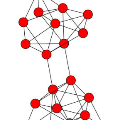Learning low-dimensional topological representation of a network in dynamic environments is attracting much attention due to the time-evolving nature of many real-world networks. The main and common objective of Dynamic Network Embedding (DNE) is to efficiently update node embeddings while preserving network topology at each time step. The idea of most existing DNE methods is to capture the topological changes at or around the most affected nodes (instead of all nodes) and accordingly update node embeddings. Unfortunately, this kind of approximation, although can improve efficiency, cannot effectively preserve the global topology of a dynamic network at each time step, due to not considering the inactive sub-networks that receive accumulated topological changes propagated via the high-order proximity. To tackle this challenge, we propose a novel node selecting strategy to diversely select the representative nodes over a network, which is coordinated with a new incremental learning paradigm of Skip-Gram based embedding approach. The extensive experiments show GloDyNE, with a small fraction of nodes being selected, can already achieve the superior or comparable performance w.r.t. the state-of-the-art DNE methods in three typical downstream tasks. Particularly, GloDyNE significantly outperforms other methods in the graph reconstruction task, which demonstrates its ability of global topology preservation. The source code is available at https://github.com/houchengbin/GloDyNE
翻译:动态网络嵌入(DNE)的主要和共同目标是在每一步都保留网络地形学的同时,有效地更新节点嵌入。大多数现有的DNE方法的构想是在最受影响的节点(而不是所有节点)上或周围捕捉地形变化,并相应更新节点嵌入。不幸的是,这种近似虽然可以提高效率,但无法有效保存每个时段动态网络的全球地形学,因为没有考虑到通过高端近距离传播的接收累积表层变化的不活动子网络。为了应对这一挑战,我们提出了一个新颖的节点选择战略,以在网络上多样性地选择代表节点,该节点与基于跳格的嵌入方法的新的渐进学习模式相协调。广泛的实验显示GloDyNE,尽管选择了一小部分节点,但每个时段都无法有效保存动态网络的全球地形学,因为接收通过高端距离相近的近端网络传播累积的表层变化。GRODFI-Artregy 任务中,GLOFAFAFSDFSUDF 的方法大大地展示了全球Slimtial-stal exstrubregy 。




